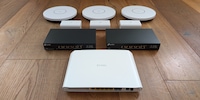
Background information
My journey to 10 Gigabit Internet
by Philipp Rüegg

What is Wi-Fi 7 and what improvements can you expect compared to Wi-Fi 6 and older standards? And why is there already hardware for it, even though the new standard may not be finalised until 2024?
The fact that manufacturers are apparently finalising their devices faster with the new standard – and sometimes even in advance – is because the technological jump from Wi-Fi 6E to 7 is smaller than with previous changes. That and the fact that most of the specifications are set well in advance.
But what does Wi-Fi 7 offer anyway? Theoretically quite a bit, since the standard now enables up to double the number of antennas. This means more end devices able to be used simultaneously and an increase in data throughput. This is further increased by providing a new, optional modulation method and wider channels in the 6 GHz frequency band. As well as this, a router can now also supply a device via two frequency bands at the same time.
However, all of this doesn’t necessarily mean an improvement: besides a router’s Wi-Fi standard, the number and size of the antennas and the CPU and RAM also play a major role. The data throughput of individual end devices won’t increase immensely, as there are hardly any notebooks or smartphones with more than two antennas.
The values listed in the table below are possible with optimal hardware equipment and the different Wi-Fi versions. The maximum data rates are only theoretical. If you can’t figure out the table right away, don’t worry – I’ll explain the most important new features in detail afterwards.
For Wi-Fi 6 and 6E, the theoretical maximum data rate with eight antennas is 9.6 gigabits per second (1.2 gigabytes per second). This is achieved through eight simultaneous streams using a 160 MHz channel bandwidth and 1024 quadrature amplitude modulation. A single stream can reach up to 1200 megabits per second. The theoretical maximum data rate for a receiving device such as a smartphone or notebook depends on the number of built-in antennas.
What does that mean in practice? Where the 2.4 GHz frequency band of a single router in the apartment can make it to the furthest corner, the 5 GHz frequency band is already sweating. And, at best, the 6 GHz frequency band manages to supply two to three rooms faster than 5 GHz can. In return, the higher frequency bands offer higher data throughput and lower latencies with good reception. 6 GHz is therefore advertised in some places as a replacement for a network cable.
If you’ve previously connected to a WLAN with an end device, this will never use more than one frequency band at the same time up to and including Wi-Fi 6E. Depending on the signal strength, it communicates with the router or its satellites at 6, 5 or 2.4 GHz. A change to another band only happens when the conditions change, for example by walking around with a laptop.
With Wi-Fi 7, thanks to Multi-Link Operation, you can be connected to two frequency bands and different channels at the same time. Bundling can result in faster speeds and lower latency. This increases the reliability of applications that depend on a fast response time and/or high data rate. The theoretical data rate of 46 gigabits per second is only possible with this technology.
Multi Resource Units (Multi RU)
If a (wide) channel is used for an end device with the predecessors of Wi-Fi 7, no other device can use it at the same time – it has to switch to another channel. Now things are different: thanks to Multi-RU, unused channel resources can now also be used by other Wi-Fi 7-enabled end devices.
More end devices – also thanks to orthogonal frequency division multiple access (from Wi-Fi 6)
More antennas enable more streams and therefore the supply of more end devices at the same time. This usually happens using Multi-User MIMO – MU-MIMO for short. MIMO stands for multiple input, multiple output. From Wi-Fi 6E to Wi-Fi 7, the maximum number of end devices that receive or transmit at the same time doubles to 16 using this technology.
Which devices for Wi-Fi 7 will be launched first?
Never before has a manufacturer introduced network products with a future standard as early as with Wi-Fi 7. The Chinese manufacturer H3C announced the Magic BE18000 router at the beginning of July 2022 – at least a year before the official launch.
There are no pre-orders from Asus yet. The Taiwanese manufacturer has already announced two Wi-Fi 7 routers, which are expected to be available from the third quarter of 2023. The fact that they won’t be available sooner suggests that Asus is waiting for certification from the Wi-Fi Alliance.
On the receiver side, there are already released, announced, and leaked chips that offer or are supposed to offer Wi-Fi 7.
Mediatek also has a first smartphone processor with Wi-Fi 7 preparation in its locker. The Dimensity 9200 was introduced in November 2022. The Vivo X90 and X90 Pro are already equipped.
There are still no definite notebook processors with Wi-Fi 7 support from Intel in the pipeline. But the company announced in August 2022 that it plans to get involved from 2024.
At Apple, on the other hand, there’s nothing to suggest that they’re working on integrating Wi-Fi 7 anytime soon. After all, the upcoming iPhone 15 is rumoured to be equipped with a Broadcom Wi-Fi 6E chip.
Header image: ShutterstockI find my muse in everything. When I don’t, I draw inspiration from daydreaming. After all, if you dream, you don’t sleep through life.
Interesting facts about products, behind-the-scenes looks at manufacturers and deep-dives on interesting people.
Show allIn the past, it felt like eternities passed between new WLAN standards. Nowadays, things progress more quickly. I’ve barely switched my first routers, notebooks and smartphones to Wi-Fi 6 and Wi-Fi 6E and 7 are already here. The first smartphone chips that support or are preparing for Wi-Fi 7 are already available. The first routers will probably start being launched from the third quarter of 2023. Wi-Fi 7 should be official soon afterwards. Originally, the Wi-Fi Alliance hadn’t planned to complete standardisation until 2024.
| Wi-Fi 7
(802.11be) | Wi-Fi 6E
(802.11ax) | Wi-Fi 6
(802.11ax) | Wi-Fi 5
(802.11ac) | Wi-Fi 4
(802.11n) | |
|---|---|---|---|---|---|
| Available frequency bands | 2.4 GHz, 5 GHz, 6 GHz | 2.4 GHz, 5 GHz, 6 GHz | 2.4 GHz, 5 GHz | 2.4 GHz, 5 GHz | 2.4 GHz, 5 GHz |
| Maximum channel bandwidth | 320 MHz | 160 MHz | 160 MHz | 160 MHz
(80 MHz required ) | 40 MHz |
| Maximum number of spatial streams | 16 | 8 | 8 | 8 | 4 |
| Theoretical maximum data rate
(gigabits per second) | 46 Gbps | 9.6 Gbps | 9.6 Gbps | 6.9 Gbps | 0.6 Gbps |
| Modulation | up to 4096-QAM
(1024-QAM required) | up to 1024-QAM | up to 1024-QAM | up to 256-QAM | up to 64-QAM |
| Other key features | Multi-Link Operation, Uplink MU-MIMO & Downlink MU-MIMO (16×16), OFDMA, Beamforming, TWT, BSS colouring, Multi-RU, Preamble Puncturing, WPA3 Security | Uplink MU-MIMO (ab Wave 2) & Downlink MU-MIMO (8×8), OFDMA, Beamforming, TWT, BSS colouring, Preamble Puncturing (optional), WPA3 Security | Downlink MU-MIMO (8×8), OFDMA, Beamforming, TWT, BSS coloring, Preamble Puncturing (optional), WPA3 Security | Downlink MU-MIMO (4×4, from Wave 2 upwards), OFDM, WPA2 Security | SU-MIMO, WPA2 Security |
The biggest change is that Wi-Fi 7 supports up to 16 antennas (16×16 MU-MIMO) – and therefore up to 16 simultaneous data streams (spatial streams). Up to eight antennas are possible with Wi-Fi 5, 6 and 6E. Of course, not all routers are equipped with the maximum number of antennas. Wi-Fi 7 will be no different. For example, since the number of antennas can make the biggest difference between different devices, I’d prefer a Wi-Fi 6 router with eight antennas to a Wi-Fi 7 router with only four antennas.
Since Wi-Fi 6E, WLAN has had a third frequency band in the 6 GHz range. The same channel bandwidths were previously options in this and the 5 GHz frequency band. Things are different with Wi-Fi 7, because now channels are no longer possible just up to 160 MHz at 6 GHz, but up to 320 MHz. Using 16 antennas and a new, optional modulation method – 4096 quadrature amplitude modulation (previously 1024-QAM) – results in a theoretical 4.8x performance over Wi-Fi 6. Or 13x over Wi-Fi 5. The new modulation method offers 12 bits instead of the previous 10, which alone means a performance increase of 20 per cent. Simply put, a modulation method ensures that data is converted into radio waves.
The maximum data rate specified for Wi-Fi 7 of an unbelievable 46 gigabits per second – i.e. 5.8 gigabytes per second – must be looked at in differentiated terms. Because this is the maximum value that 16 streams can deliver using a new 320 MHz channel in the 6 GHz frequency band plus a 160 MHz channel in the 5 GHz frequency band with 4096-QAM. It should be noted that the higher the frequency used, the shorter distance radio travels. And that the new channel width of 320 MHz is only available in the least far-reaching 6 GHz frequency band.
Perhaps the 6 GHz frequency band is only able to generate more data throughput in the room in which the router is located. In addition to the frequency, how far radio can travel depends heavily on how thick the walls are, what they’re made of and whether underfloor heating or other disruptive factors between the router and the receiving device have a negative effect on the radio. This means that a Wi-Fi 7 router with the same number of identical antennas as a Wi-Fi 6 router only provides a little additional performance over an entire apartment. So the 4.8x value implied with 46 gigabits per second compared to 9.6 gigabits with Wi-Fi 6 is pure window dressing in most cases.
As of Wi-Fi 6, orthogonal frequency division multiple access technology is available in addition to MU-MIMO. Like MU-MIMO, OFDMA is multi-user technology that makes it possible to exchange different data with different devices at the same time (downlink and uplink). Depending on the situation, the router decides to use either MU-MIMO or OFDMA. The former will be used for streams with high data throughput. OFDMA technology is made for the opposite: it divides a radio channel into smaller sub-channels. For example, a 20 MHz channel can be split into up to nine channels. The router then allocates a time interval to the respective sub-channel and alternately supplies the sub-channels, i.e. different end devices, with data, and this all happens at extremely short intervals. The narrow time windows ensure that everything happens virtually seamlessly.
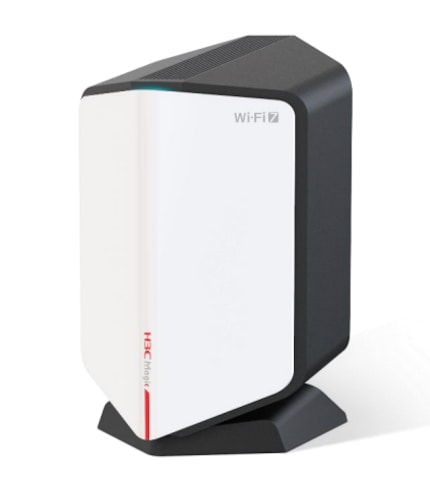
This announcement was soon followed by several others from other manufacturers. Likewise, the first systems-on-chip (SoC) with Wi-Fi-7 integration are waiting in the wings or already out there, paving the way for mobile devices such as laptops and smartphones. It’s unclear whether H3C will market its router in Europe and whether it’ll be launched before or after Wi-Fi 7 certification. Generally speaking, there are currently no routers available with Wi-Fi 7. Some manufacturers, however, are already offering one or the other device for pre-order.
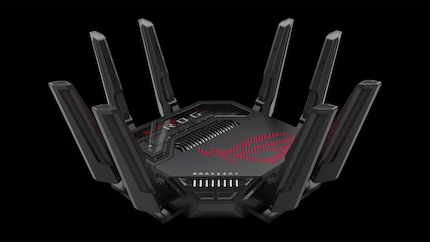
We’re talking about the Asus RT-BE96U presented at CES 2023 and the ROG Rapture GT-BE98 gaming router. Both are routers with eight antennas and two or three 10 Gigabit network connections.
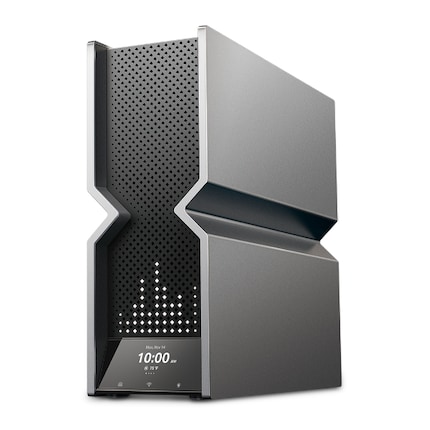
Back in November 2022, TP-Link unveiled over half a dozen Wi-Fi 7 routers. Among them are three Deco and three Archer models. The Archer BE900 | BE24000, which aims to impress with an hourglass design, an LED display and twelve antennas. In addition to other connections, it also offers two 10-gigabit ports. Individual retailers have already listed some of the new TP-Link routers in their shops and are allowing pre-orders. The devices should be on the market in the coming months – whatever that means.
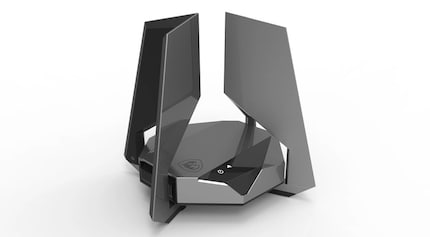
At CES 2023, MSI unveiled a Wi-Fi 7 router with four blades that house antennas. What’s special about the RadiX BE22000 Turbo is that the four blades are automatically aligned with a motor to improve reception as soon as the router has analysed the situation on-site. MSI has not yet published the exact hardware specifications. Among other things, it should have two 10-gigabit network connections. When this miracle product will be launched is not yet clear.
A Qualcomm leak indicates that a notebook processor or SoC with integrated Wi-Fi 7 will come onto the market towards the end of 2023. It’s the Snapdragon 8cx Gen 4, which could fuel Windows for ARM processors at new speeds. The company already presented a smartphone processor with Wi-Fi 7 back in November 2022. This function was prepared for the Qualcomm Snapdragon 8 Gen 2 (article in German) and will therefore be available as soon as the standard is official. The first smartphones with this will include the Xiaomi 13, the Nubia Red Magic 8 Pro+ and the Vivo iQOO 11 and X90 Pro Plus.